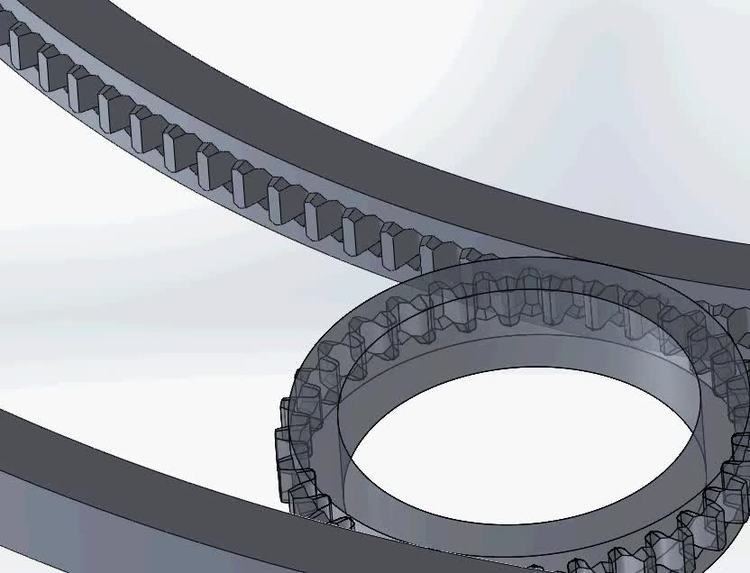 | ||
Gear bearing – a kind of rolling-element bearing in the style of an epicyclic gear. Each gear bearing consists of a series of small 'satellite' gears which revolve around the center of the gear bearing in a track defined at its outer edge by an internal gear and at its inner edge by an external ring gear. Each gear is sandwiched in-between concentric rollers. Therefore, widths of all involved gears must be the same.
Contents
Engagement
The teeth must be either made beveled and/or made with engagement by surfaces providing the efficient axial meshing. This avoids misalignment, sticking, and reduces sliding friction in the bearing gearwheels, engagements on adjacent end faces of their gearwheels, and rollers. For the instance the illustrations present implementations of bearing gears with beveled teeth and rollers on their adjacent end faces as well as a herringbone engagement to provide minimal axial shift due to opposite sloping teeth.
Work
Neglecting clearance and assuming perfect accuracy, engagement of bearing gears is aimed at maximum rolling with minimum sliding friction of conjugated profiles in movement. End rollers ensure limiting of gear radial shift at their contact points, thus, along with their engagement, slip-free rolling motion of their conjugated pairs is implemented. Adjacent end faces of teeth and rollers limit axial shift of conjugated bearing gears performing their plane-parallel motion. In such a way, using bearing gears as sun, ring and more than two satellites uniformly distributed among them the entire gear bearing is arranged, and carrier may be used instead of ring or sun gearwheels, or it may act as frame unit and transfer rotation from satellites, whereas limitation of carrier degrees of freedom would form redundant constraints or serve as additional basis for force distribution in mechanism. In case less than three bearing satellite gearwheels are involved, at least axles of movable sun and/or of ring bearing gearwheels should be fixed relative to housing parts.
Usage
Gear bearings could be used as more efficient bearing as planetary gear mechanism with simplified kinematic relations and/or suspension, also in double row planetary gear and their combinations. In particular, in systems of direct analog indications in measuring instruments and planetary watches.
Linear gear bearings can easily be made with straight tracks. One, cast in bronze, is used as the expansion joint in the centre of Kingsgate Bridge.
Implementations
The implementation of bearing gearwheels may be a one-piece manufacture or a fixed joint assembly using: screws, bracers, threaded connections, pressure coupling, soldering, welding, gluing, or friction coupling in the form of sliding safety clutch or friction connection. The gear bearing may be assembled from separate sectional parts or by joining with optional elastic and/or thermal deformation in the manufacturing sequence.
